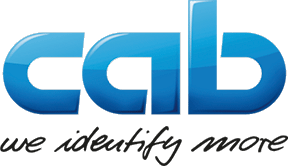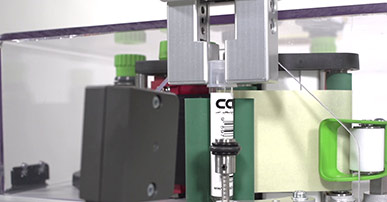Marking in the laboratory with cab label printers
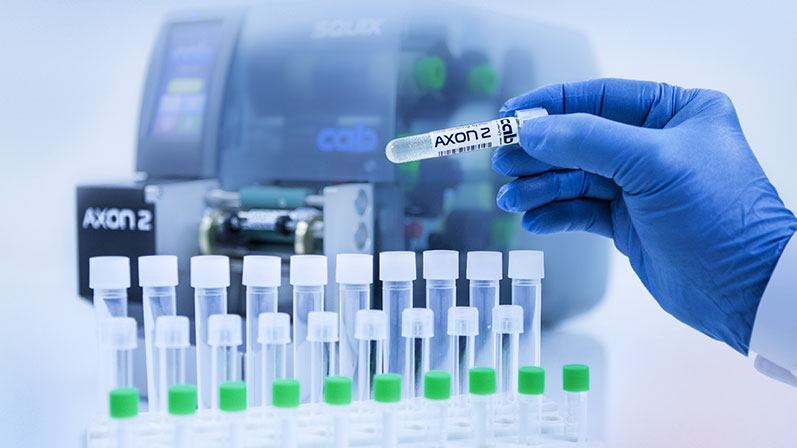
In labs, labeling is no longer, and has not been for a long time, just a possibility of identifying containers. Samples, reagents and preparations are in use in patient diagnostics and worldwide in clinical, biotechnical, pharmaceutical and academic research. At these, Good Laboratory Practice (GLP) demands labeling processable by machines. For fast and reliable analyses and for reasons of traceability, identities and data related to manufacture and expiration must be visible. Specific codes and numbers have to remain legible during processing and long-term stock. Chemicals require two-color pictograms, medical devices unique IDs. Personal data must be kept private. Thermal transfer printing and laser marking provide high quality as required by labs.
cab label printers ensure permanent imprint
Thermal transfer printers enable printable resolutions of 600 dpi, high contrast and sharp-edge imprints even in marginal areas. So, even tiny fonts can be verified perfectly with the eye and tiny barcodes be verified by scanners. Comprehensive research in terms of time and costs, limitations in patient care or delays in medical development and production are reduced to a minimum. Thermal printing also means no waiting for ink to dry. Any number of labels wound on rolls can be printed non-stop. Imprints remain clearly legible when exposed to mechanical influences, water or solvents.
Labs generally increase productivity and turn identification more reliable by purchasing consumables adapted to a printer. Steam pressure sterilization, sample stock at temperatures as near as 200 °C below zero in liquid nitrogen, as well as dyeing processes can cause damage to a label, impede its readability or peel it off a container. Labels and ribbons (equivalent to color tapes known of common printers) recommended by cab for lab processes are tested for all common resistances. Label surfaces are optimized for thermal transfer, roll diameters and cores adapt to cab printers, so does the winding.
Sample tubes
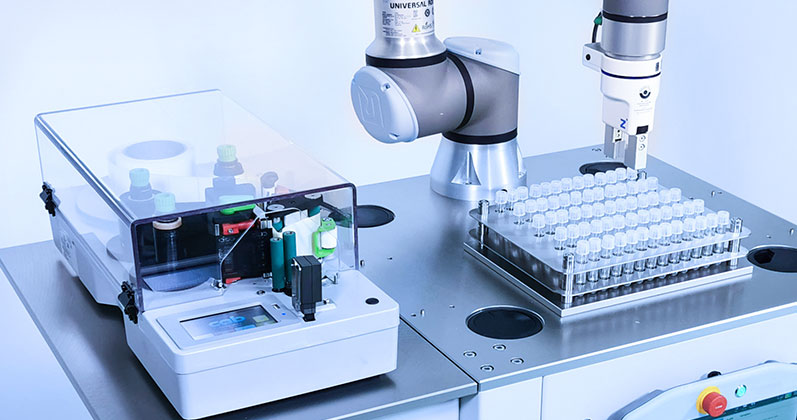
Some samples formed, analyzed microscopically or stored in a lab are irreplaceable. Their value is accordingly high. Regularly, they are processed in tubes. Tube labeling can be performed particularly quick and reliable with the help of printer models, into which tubes can be inserted manually or automatically, for example by a robot, and which integrate a unit to apply the labels. Tubes inserted to such a device are labeled straight after printing. Labeled tubes can be removed one by one or collected in a tray.
The cab AXON 2 model has been designed for labeling tubes of diameters 10 to 17 mm, capped or uncapped. 35 mm will be possible with the AXON 1 model, to be launched early in 2021. In case of AXON 1, tubes are inserted from above vertically upright. Its flat design facilitates installation wherever space is limited in a lab. As for AXON 2, tubes are labeled in horizontal orientation in a classic printer chassis. A full package consisting of a smart firmware, cab's lean-encoded printer programming language and a highly performant CPU results in fast processing. Printing and applying a label takes less than two seconds on both AXON models.
To the topic
Object carriers
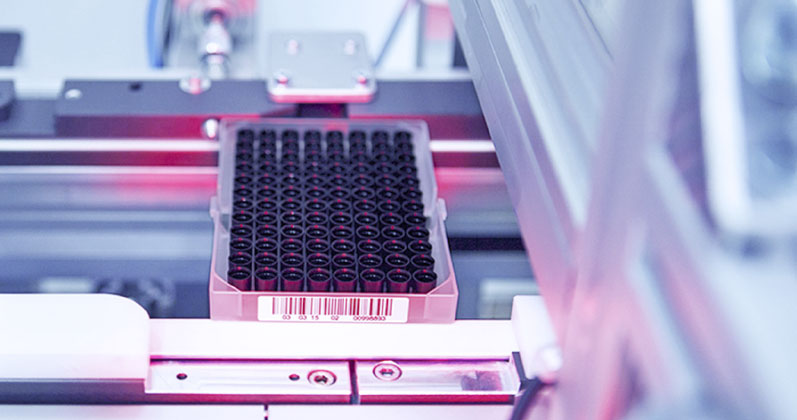
Modular print and apply systems are first choice if carrier systems of different sizes or geometries have to be labeled accurately. An extra unit is therefore assembled to a label printer to apply the labels. Such units provide transfer stamps. Stroke lengths are selected appropriate to the height of a target item, stamps are selected according to the surface structure of this item. For example, labels printed by a cab SQUIX printer can be applied to test tube carriers by a lifting applicator. A rotary and a lifting cylinder can be combined to label microtiter plates. In addition, different systems help with labeling cylindric items on a 360° circumference.
To the topic
Label printer SQUIX with Applicator S3200
Print and apply system HERMES Q
Case study: Marking of pharmaceutical bins with a Hermes+ system
Hazardous substances

Potentially hazardous substances such as chemicals are subject to classification according to the Globally Harmonized System (GHS). As a signal to consumers and the environment, they must be labelled in red and black. The CLP regulation defines the labeling and packaging of substances and mixtures in Europe, specifies requirements related to labels and sizes of warning symbols.
Usually, label printers work monochrome. cab printers of the XC series were the first to provide two print heads on a device. Two-color printing is therefore possible in one operation. Labs have no longer to stock large numbers of pre-printed labels in order to label hazardous substances. If labels are printed only in parts, one print head is lifted and the ribbon stopped during label transport. This automatic saving significantly reduces consumption of the ribbon that serves as the spot color.
To the topic
Print and apply system Hermes C
Antibody testing
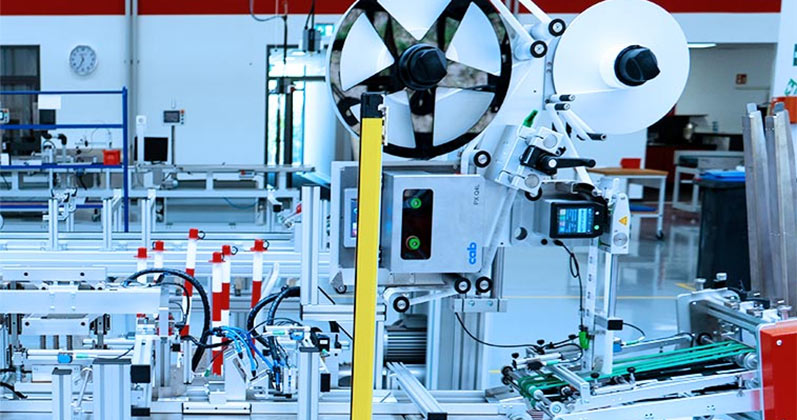
SARS-CoV-2 presents challenges to labs. Amongst others, test cassettes are required to detect antibodies within few minutes using a blood sample. These must also be identified in a unique way compliant to the guidelines on serialization and traceability. Such cassettes are manufactured and packed in pouches in industrial plants. A print module and a labeling head can be integrated in such plants to label the pouches compliant to pharmaceutical regulations. See a video: www.cab.de/en/kraus-video
To the topic
Case study: Covid-19 rapid test: A combination of machines providing, labeling and packing
Lab logistics
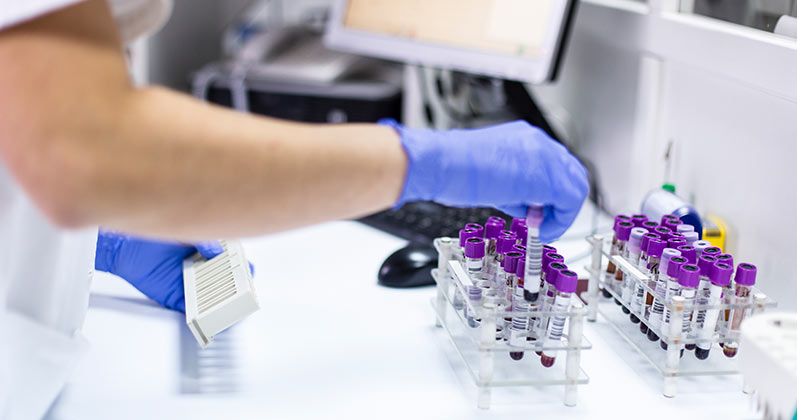
Health demands safety awareness. Lab samples or blood bags have to be delivered to the correct recipient, for example hospitals, research institutes and pharmacies. Guidelines related to the processing and stock of medical goods also apply to their dispatch and transport, especially with regard to repackaging and its identification. Clearly printed labels accelerate secure turnover.
To the topic
Label printer for laboratory identification
Labels and ribbons in medical technology
Lab-related instruments and microscope slides
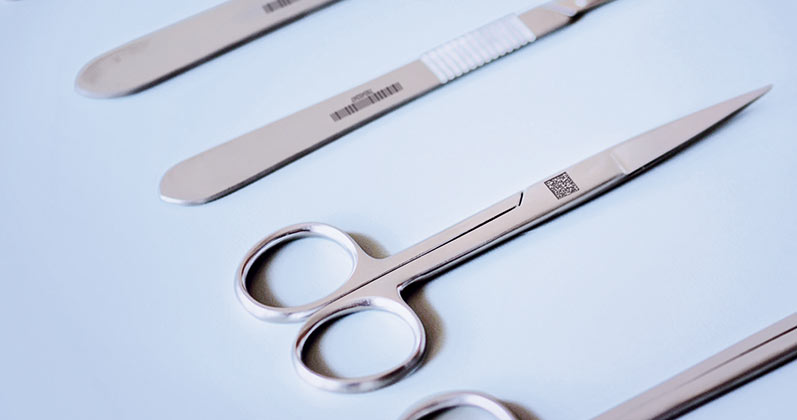
Tweezers, pliers or scissors are indispensable auxiliaries, used in labs again and again. Unique Device Identification (UDI) sets requirements on markings tamper-resistant and directly on an item. At this, a laser is particularly economical. Compact desktop systems such as cab’s XENO 1 fit with lab processes. They integrate a laser source and a control unit in a joint protective chassis according to laser protection class 1. The systems are delivered ready for operation. Side opening of the chassis ensures mutual access in an optimum way and provides a good setup of marking positions with a pilot laser.
Laser markings are of a high contrast and ensure reliable traceability over the entire life cycle. Possible inadequacies such as a complaints as a result of inspection are eliminated. Glass slides picking up preparations for analysis on a microscope can also be clearly marked with a laser.
To the topic
Economical automation

Lab work usually includes receipt of orders, formation of samples, their centrifugation and analysis according to specific parameters. Results are validated, samples and data documented and archived, reports transmitted. More and more automated LIMS are in use assuring quality according to ISO standards, managing all data transfers inhouse, to authorities or clients. Employees, systems and their components continuously feed in data, process data or remove data from such information systems. Labs benefit from accelerated processes, high productivity and quality, customers from reduced costs.
Services embedded in these information systems are increasingly hosted in the cloud. Data related to orders and analyses are transferred in an encrypted mode to the web and can thus be exchanged easily and in a secure way between different systems. To integrate to a network, cab devices provide all the necessary physical interfaces as a standard. Norms such as OPC-UA standardize interactions and communication independent from platforms. Control or measuring values can be exchanged in a secure way. The WebDAV transfer protocol enables virtual memories be integrated to cab devices via a network. The web memory can thus be accessed as a drive anywhere.
To the topic
Networked labeling with OPC UA
Printing labels using WebDAV: Access data from anywhere
Secure data

When integrating components to a network, when administration and authentication are required, the protection of personal data becomes a key issue. Solutions on this are an integral part of the cab product development. cab label printers provide all common protocols to protect data in a lab network. For example, permissions can be assigned to users and restricted by passwords. USB slots and access to external storage media may be locked, wireless connection via WLAN or Bluetooth be switched on or off. Access to network services such as HTTP, FTP or VNC is possible only with authorization. Network protocols can be encrypted, algorithms for highest levels of security are supported, firmware updates verified for integrity before installation. To connect securely in a network, a certificate as required is installed in a printer ex factory.
To the topic
